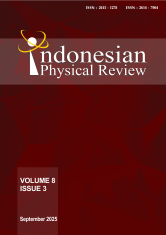LANDSLIDE VULNERABILITY ANALYSIS BASED ON THE SEISMIC VULNERABILITY INDEX USING THE HVSR MICROTREMOR METHOD ON CLIFF AREAS IN HANURA VILLAGE, TELUK PANDAN DISTRICT, PESAWARAN REGENCY
DOI:
10.29303/ipr.v8i3.484Downloads
Abstract
Way Ratai Road in Pesawaran Regency connects tourist areas managed by the Lampung Provincial Government. This road has cliffs with steep slopes, which have the potential to cause landslides. This research is very important because Way Ratai road is the only access road to Pesawaran beach tourism which is the main tourist destination of Lampung Province. Moreover, Way Ratai road is also the only access road connecting to the provincial capital of Bandar Lampung. This research was conducted to determine the soil vulnerability to seismic vibration on two cliffs around Way Ratai Road, Teluk Pandan District, Pesawaran Regency. The method used was microtremor signal recording with the Horizontal Vertical to Spectral Ratio (HVSR) method to determine the amplification factor (), dominant frequency (), sediment thickness (H), and seismic vulnerability index (Kg). The first cliff's measurement and data processing results showed an amplification factor () value of 2.74 - 3.70, a dominant frequency () of 3.75 - 4.56 Hz, a sediment thickness (H) of 14.09 m, and a seismic vulnerability index (Kg) of 2.39 m²/s. On the second cliff, the results showed an amplification factor () value of 2.27 - 3.40, a dominant frequency () of 3.54 - 7.20 Hz, a sediment thickness (H) of 9.33 m, and a seismic vulnerability index (Kg) of 1.84 m²/s. In term of seismic vibration, both cliffs, prone to landslides, have high stability against seismic vibrations. In the event of a landslide on these two cliffs, the estimated slip surface on the first cliff would be translational, and the second cliff would be a combination of translational and slight rotational, with an estimated volume of soil that could potentially slide on the first cliff is 30,492.16 m³ and on the second cliff, it is 27,188.92 m³.
Keywords:
Landslides Pesawaran Microtremor HVSR Seismic Vulnerability IndexReferences
[1] D. Karig, "Evolution of Arc Systems in the Western Pacific," Annual Review of Earth and Planetary Sciences, vol. 2, pp. 51-75, 1974.
[2] M. Crow, Sumatera Geologi, Resources and Tectonic Evolution, London: The Geological Society, 2005.
[3] BNPB, "Pusat Data Informasi dan Komunikasi Kebencanaan," Bidang Pengelola Data dan Sistem Informasi, [Online]. Available: https://dibi.bnpb.go.id/. [Accessed 01 September 2023].
[4] Linfeng Fan, "Linking rainfall-induced landslides with debris flows runout patterns towards catchment scale hazard assessment," Geomorphology, vol. 280, pp. 1-15, 2017.
[5] I. N. Permanasari, "Determination of Slip Using 2D Geoelectric Resistivity Method and Laboratory Analysis for Landslide Prone Area Pesawaran, lampung," Earth and Environmental Science, p. 537, 2020.
[6] Guzzetti, "Landslides in a changing climate," Earth-Science Reviews, vol. 162, pp. 227-252, 2016.
[7] M. Alvioli, "Scaling properties of rainfall induced landslide predicted by physically based model," Geomorphology, vol. 213, pp. 38-47, 2014.
[8] K. Pesawaran, "Wilayah Geografis Pesawaran," Pemerintah Provinsi Lampung Kabupaten Pesawaran, [Online]. Available:
[9] https://pesawarankab.go.id/Profil_Pesawaran/wilayahgeografis. [Accessed 8 Agustus 2023].
[10] N. Haerudin, Mikroseismik, Mikrotremor dan Microearthquake dalam ilmu kebumian, Bandar Lampung: Pusaka Media, 2019.
[11] W. B. Hamilton, "Tectonics of the Indonesian region," Geol.Soc, pp. 3-10, 1973
[12] S.A. Mangga dan Amirudin, "GeoMap," Badan Geologi, 1 Januari 2010. [Online]. Available: https://geologi.esdm.go.id/geomap/pages/preview/peta-geologi-lembar- tanjungkarang-sumatera. [Accessed 04 Desember 2023].
[13] Rustasi dan R. Eko, "Formasi Batuan dan Site Class Di Bandar Lampung," Jurnal Geofisika EKsplorasi, vol. 6, no. 3, pp. 183-189, 2020.
[14] P. Kearey, An Introduction to Geophysical Exploration, Oxford: Blackwell Science, 2002.
[15] V. Ipmawan, ""Spatial Analysis of Seismic Hazard Based on Dynamical Characteristics," Journal of Science and Application Technology, vol. 1, no. 1, p. 1, 2019
[16] Fattah, "Fundamental Frequency Anomaly Around," , IOP Conference Series: Earth and Environmental Science, vol. 537, 2020.
[17] Olegario Alonso, “A Comparative Analysis for Defining the Sliding Surface and Internal Structure in an Active Landslide Using the HVSR Passive Geophysical Technique in Pujilí (Cotopaxi), Ecuador”, MDPI: Land, vol. 12, 2023.
[18] Arie Satria, "Analisis Mikrotremor Berdasarkan Metode Horizontal to Vertical Spectral Ration Untuk Mengtahui Indeks Kerentanan Seismik Kota Jambi," Jurnal Teknik Kebumian, vol. 6, no. 1, pp. 1-6, 2020.
[19] Arai, "S-Wave Velocity Profiling by Joint Inversion of Microtremor Dispersion Curve and Horizontal-to-Vertical (H/V) Spectrum," Seismological Society of America, vol. 95, no. 5, pp. 1776-1778, 2005.
[20] Mojtaba Hosseinzadeh, “Dynamic response evaluation of landslide to ambient noise using the HVSR method, the case of golay landslide in North Khorasan Province, Iran”, Springer Nature: Bulletin of Engineering Geology and the Environment Volume 84, article number 251, 2025.
[21] S. Imposa, S. Grassi, F. Fazio, G. Rannisi, P. Cino, “Geophysical surveys to study a landslide body (North-Eastern Sicily)”, Nat. Hazards, 86, pp. 327-343, 2017
[22] V. Pazzi, L. Tanteri, G. Bicocchi, M. D’Ambrosio, A. Caselli, R. Fanti, “H/V measurements as an effective tool for the reliable detection of landslide slip surfaces: case studies of Castagnola (La Spezia, Italy) and Roccalbegna (Grosseto, Italy)”, Phys. Chem. Earth ABC, 98, pp. 136-153, 2017.
[23] S. Martino, M. Cercato, M. DellaSeta, C. Esposito, S. Hailemikael, R. Iannucci, G. Martini, A. Paciello, G. Scarascia Mugnozza, D. Seneca, F. Troiani, “Relevance of rock slope deformations in local seismic response and microzonation: insights from the Accumoli case-study (central Apennines, Italy)”, Eng. Geol., 266, 2020.
[24] O. Alonso-Pandavenes, D. Bernal, F.J. Torrijo, J. Garzón-Roca, “A comparative analysis for defining the sliding surface and internal structure in an active landslide using the HVSR passive geophysical technique in Pujilí (Cotopaxi), Ecuador”, Land, 12, p. 961, 2023.
[25] Arie Satria, "Analisis Mikrotremor Berdasarkan Metode Horizontal to Vertical Spectral Ration Untuk Mengtahui Indeks Kerentanan Seismik Kota Jambi," Jurnal Teknik Kebumian, vol. 6, no. 1, pp. 1-6, 2020.
[26] Arai, "S-Wave Velocity Profiling by Joint Inversion of Microtremor Dispersion Curve and Horizontal-to-Vertical (H/V) Spectrum," Seismological Society of America, vol. 95, no. 5, pp. 1776-1778, 2005.
[27] Muntohar, Tanah Longsor, Yogyakarta: Universitas Muhammadiyah Yogyakarta, 2009.
[28] INP Permanasari, "Mathematical Model of Landslides With Curved Sliding Plane Using Fracture Criterion (τ-σ) of Solid Soil-Rock System," vol. 7, no. 1, pp. 1-8, 2022.
[29] Kanai, Engineering Seismology, Tokyo: University of Tokyo Press, 1983.
[30] M.Mucciarelli, "The stability of the horizontal-to-vertical spectral ratio of triggered noise and earthquake recordings," Bulletin of the Seismological Society of America, vol. 93, no. 3, pp. 1407-1412, 2003.
[31] Y. Nakamura, "On the H/V Spectrum," Word Conference on Earthquake Engineering, 2008.
[32] Y. Nakamura, "Seismic Vulnerability Indices For Ground and Structures Using Microtremor," World Congress on Railway Research, 1997.
[33] Y. Nakamura, "A Method for Dynamic Characteristics Estimation of Subsurface using Microtremor," Quarterly Report of Railwat Technical Research Institute (RTRI), vol. 1, pp. 25-33, 1989.
License

This work is licensed under a Creative Commons Attribution-NonCommercial-ShareAlike 4.0 International License.
Authors who publish with Indonesian Physical Review Journal, agree to the following terms:
- Authors retain copyright and grant the journal right of first publication with the work simultaneously licensed under a Creative Commons Attribution-ShareAlike 4.0 International Licence (CC BY SA-4.0). This license allows authors to use all articles, data sets, graphics, and appendices in data mining applications, search engines, web sites, blogs, and other platforms by providing an appropriate reference. The journal allows the author(s) to hold the copyright without restrictions and will retain publishing rights without restrictions.
- Authors are able to enter into separate, additional contractual arrangements for the non-exclusive distribution of the journal's published version of the work (e.g., post it to an institutional repository or publish it in a book), with an acknowledgment of its initial publication in Indonesian Physical Review Journal.
- Authors are permitted and encouraged to post their work online (e.g., in institutional repositories or on their website) prior to and during the submission process, as it can lead to productive exchanges, as well as earlier and greater citation of published work (See The Effect of Open Access).





